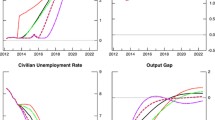Abstract
We employ threshold cointegration methodology to model the policy problem solved by the Federal Reserve System in their manipulation of the discount rate under a reserves target operating procedure utilized since October 1979. The infrequent and discrete adjustments that characterize movements in the discount rate instrument vis-a-vis the Federal Funds rate do not lend themselves to a linear cointegration framework. The inherently nonlinear relationship arising from the Fed's self-imposed constraints on discontinuously changing the discount rate is satisfactorily modelled as an instance of threshold cointegration between the discount rate and the Federal Funds rate.
Similar content being viewed by others
References
Andrews, D.W.K. (1993). Tests for parameter instability and structural change with unknown change point, Econometrica 61: 821-856.
Bai, J. and Perron, P. (1994). Testing for and Estimation of Multiple Structural Changes, unpublished working paper, M.I.T., (October).
Balke, N. and Fomby, T. (1994). Threshold Cointegration, unpublished working paper, Southern Methodist University, (October).
Cook, T. (1989). Determinants of the Federal funds rate, 1979-1982, Federal Reserve Bank of Richmond Economic Review 75: 3-19.
Engle, R. and Granger, C.W.J., (1987). Co-integration and error correction: representation, estimation and testing, Econometrica 55: 251-276.
Goodfriend, M. (1983). Discount window borrowing, monetary policy, and the post-October 6, 1979 Federal Reserve operating procedure, Journal of Monetary Economics 12: 343-356.
Goodfriend, M. (1991). Interest rates and the conduct of monetary policy, Carnegie-Rochester Conference Series on Public Policy, 34: 7-30.
Goodfriend, M. and Whelpley, W. (1986). Federal funds: instrument of Federal Reserve policy, Federal Reserve Bank of Richmond Economic Review, (September-October), 3-11.
Hansen, B. (1996). Inference where a nuisance parameter is not identified under the null hypothesis, Econometrica, 64: 413-430.
Karasulu, M. (1995). Essays on the European exchange rate target zone, unpublished Ph.D. dissertation, Boston College.
Keir, P. (1981). Impact of discount policy procedures on the effectiveness of reserve targeting, in New Monetary Control Procedures, Federal Reserve Staff Study, Vol. 1, (February).
Kwiatkowski, D., Phillips, P.C.B., Schmidt, P. and Shin, Y. (1992). Testing the null hypothesis of stationarity against the alternative of a unit root: How sure are we that economic time series have a unit root?, Journal of Econometrics 54: 159-178.
Peristiani, S. (1991). The model structure of discount window borrowing, Journal of Money, Credit and Banking 23(1): 13-34.
Priestley, M.B. (1988). Non-linear and Non-stationary Time Series Analysis, Academic Press, London.
Tinsley, P. et al. (1982). Policy robustness: specification and simulation of a monthly money market model, Journal of Money, Credit and Banking 14(4): pt. 2 829-856.
Tong, H. (1983). Threshold Models in Non-linear Time Series Analysis, Lecture Notes in Statistics Vol. 21. Springer-Verlag, New York.
Tong, H. (1990). Non-linear time series: A dynamical system approach. Clarendon Press, Oxford.
Tsay, R. (1989). Testing and modeling threshold autoregressive processes, Journal of the American Statistical Association 84: 231-240.
Author information
Authors and Affiliations
Rights and permissions
About this article
Cite this article
Baum, C.F., Karasulu, M. Modelling Federal Reserve Discount Policy. Computational Economics 11, 53–70 (1997). https://doi.org/10.1023/A:1008622613557
Issue Date:
DOI: https://doi.org/10.1023/A:1008622613557




